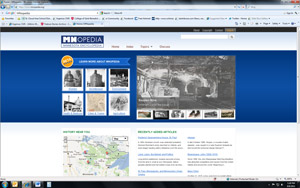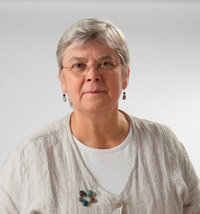Making Minnesota history fun and smart
CSB/SJU history professor has essay published on new online Minnesota encyclopedia
September 8, 2011
By Mike Killeen

Annette Atkins knows a thing or two about assignments. She is, after all, a professor of history and the Flynn Professor in the Humanities at the College of Saint Benedict and Saint John's University, and assignments are a regular part of her courses.
But when she began a writing assignment for MNopedia - a prototype online encyclopedia about Minnesota - she made a slight miscalculation.
"I started down the path of writing a 10,000-word essay, which is about 40 pages," Atkins said. "A 40-page essay, in my mind, is a big essay. No chapter in any of my books was 40 pages. I just tend to write shorter than that."
So Atkins wrote - and wrote some more. She reached approximately 8,900 words and called Erica Hartmann, MNopedia editor and project manager with the Minnesota Historical Society Press.
What happened? "I looked at the contract and it was for 2,000 words," Atkins said, smiling. "It may be the best thing I've ever written, because I had to go from 9,000 words down to 2,000 words. So, I cut out lots of big chunks. It kind of just forces you to make every word count."
Her essay on how cities and towns have shaped the development of Minnesota is one of the featured stories currently on the new website.
 "We're hoping it will be a comprehensive A-Z resource about Minnesota," Hartmann said of MNopedia. "Right now, it's a small working model. Hopefully, it will get more useful as we find more contributors."
"We're hoping it will be a comprehensive A-Z resource about Minnesota," Hartmann said of MNopedia. "Right now, it's a small working model. Hopefully, it will get more useful as we find more contributors."
That's where Atkins - who has written several books on Minnesota history and is currently working on a draft of the history of the College of Saint Benedict for the school's centennial - comes in.
Both Atkins and Hartmann said a Minnesota printed encyclopedia was discussed in the early 2000s, but was dismissed because of cost and budget cuts.
When Minnesota voters approved the Clean Water, Land and Legacy Amendment in 2008, a portion of the funding was to be used to preserve Minnesota's history and cultural heritage.
"This was a project that was ready to take off," Atkins recalled. "It had some preliminary planning, and there had been people thinking about it already.
"By the time there was funding available, online was the only way to go. With an online encyclopedia, you can update it all the time. You make it much more flexible, and much more usable. And, you get much more feedback."
Hartmann asked contributors like Atkins and Larry Millett - a 1969 graduate of SJU who wrote an essay on architecture in Minnesota - to write in a style that would "invite people in rather than push them away," Atkins said.
"These essays are really designed not to show off the intelligence of the writer so much as to orchestrate a conversation," Atkins said. "Erica was asking us to write hospitable essays."
That approach is evident in Atkins' essay. In her opening paragraph, she states that only outsiders and strangers - and those who name baseball teams - would call St. Paul and Minneapolis "twins" when the state's two largest cities are so decidedly different. Later, she chides the two cities for not having the same snow emergency rules ("Wouldn't every citizen's life be improved" if that happened, she pleads.)
"Mine - and all the essays - are based on really extensive research and mastery in the field," Atkins said. "But, they're designed to wear that scholarship lightly, rather than as a suit of armor."
"I wanted to make sure that what was being written was both accurate and interesting," Hartmann said. "She (Atkins) has a real knack for telling a tale and making Minnesota history interesting. Her essay is particularly successful at that. That will be a goal for us going forward."
Hartmann said the target audience of MNopedia is "pretty broad" - including teachers, students, parents, researchers, journalists and tourists.
"It's going to be a nice way for a lot of people to tell the story of Minnesota history to include a variety of perspectives on a variety of topics and to do it in a way that's going to be useful to people," Hartmann said.
"It's fun and smart. What more could you want from an encyclopedia?" Atkins said.
